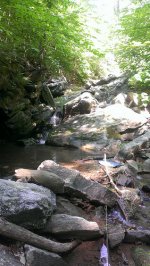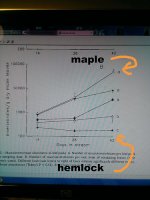k-bob
Well-known member
- Joined
- Jul 29, 2009
- Messages
- 2,376
General significance of in-stream large woody debris for pool formation understood. However, for a high-gradient stream (7+% gradient, for example), boulders can be big enough to provide pools even at very low flow levels -- as in the very low-flow brookie-stream image below. btw, this ravine stream stays cool, probably due to groundwater input. it might have had lower fertility and lower trout biomass 125 years ago when it had a hemlock ravine, due to the relatively poor food hemlock needles provide to invertebrates. today, it's in a mixed forest whose leaf litter may well produce more macros (article post 57 above)... it def has the brookies!
this sort of steep cold stream may be unusual... but that's the point, really. I agree that most PA streams that have brookies today had more brookies in the past... but some small percent may have more brookie biomass now... if the hemlock forest of this ravine could be restored, the steep little run might look great, but I am not sure it would have more brook trout biomass.
this sort of steep cold stream may be unusual... but that's the point, really. I agree that most PA streams that have brookies today had more brookies in the past... but some small percent may have more brookie biomass now... if the hemlock forest of this ravine could be restored, the steep little run might look great, but I am not sure it would have more brook trout biomass.







